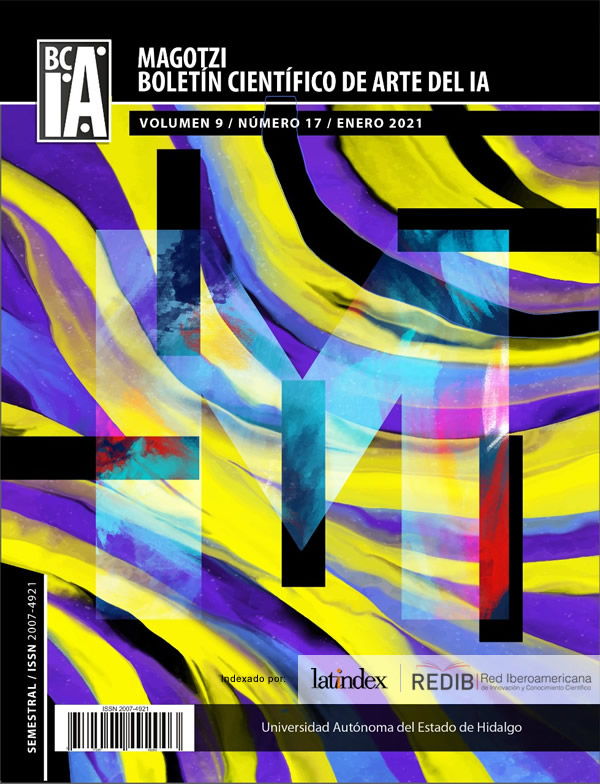Symbolic dimensions inscribed in classical dance labour: experiences from the body of the dancer
Abstract
The bodies of the dancers that move in the classical dance field are located in the intersection of the memory of the individual body and the collective body; in this network of fights between the self and the other, the research has set as general objective an approach to the field of classical dance towards the body of the dancer, in order to apprehend the meanings that are elaborated dialectally in the social phenomena of dance labour. In consideration of this prior ideas, the experiences of nine classical dancers in Mexico City were reconstructed, these experiences were weaved towards the theory, considering essentially two dimensions: habitus and field; the family, school and labour as institutions where the habitus of the subject is conformed, and the profession of the dancer, comprehend as the field. In this analysis several variables were recognized, such as process of constitution of the field, meaning of the body in classical dance, discipline and pain as symbols in the field, permanent vigilance over the body, among others; which combined can improve the understanding towards the matter of study.
Downloads
References
Aalten, A. (2007). Listening to the dancer ́s body. Sociological Review, 55, 1, 109-125. Doi. 10.1111/j.1467-954X.2007.00696.x
Andreella, F. (2010). El cuerpo suspendido. Códigos y símbolos de la danza al principio de la modernidad. México: INBAL.
Baz, M. (1994). Enigmas de la subjetividad y análisis del discurso. Versión. Estudios de Comunicación y Política: Etnografía y Comunicación, 4, 117-156. http://ccdoc.iteso.mx/acervo/cat.aspx?cmn=download&ID=463&N=1.
Berger, P. y Luckmann, T. (2003). La construcción social de la realidad. Argentina: Amorrortu Editores.
Bourdieu, P. (1997). Razones Prácticas. Sobre la teoría de acción. Barcelona: Editorial Anagrama.
Criado, E. (2013). Cabilia: la problemática génesis del concepto de habitus. Revista Mexicana de Sociología, 75, 1, 125-151. http://www.redalyc.og/articulo.oa?id=32125628007
Dallal, A. (1997). Procesos espontáneos e inducidos en el arte dancístico. Revista Mexicana de Ciencias Sociales y Políticas, 41, 170, 13-33. http://dx.doi.org/10.22201/fcpys.2448492xe.1997.170.49297
Ferreiro, A. (2005). Escenarios rituales. Una aproximación antropológica a la práctica educativa dancística profesional. México: Colegio de Estudios de Posgrado de la Ciudad de México/CENIDI Danza/INBA/CENART/CONACULTA.
Fernández, M. L. (2007). Cultura y poder en la danza contemporánea. Ensayo sobre una disciplina plebeya en México. Tesis de licenciatura, Escuela Nacional de Antropología e Historia.
Foucault, M. (2002). Vigilar y castigar. Argentina: Siglo XXI Editores.
Giménez, G. (2005). Teoría y análisis de la cultura I. México: CONACULTA e ICOCULT.
Islas, H. (1995). Tecnologías corporales: danza, cuerpo e historia. México: CENIDI Danza/INBA.
Katz, H. (2015). Palavra que eu uso me inclui nela. En Katz, H. (Autor), Um, dois, três, a dança é o pensamento do corpo, pp. 7-61. Belo Horizonte: Fórum Internacional de Dança.
Le Breton, D. (2012). Sobre algunas ambigüedades. En La sociología del cuerpo, pp. 25-32. Buenos Aires: Ediciones Nueva Visión.
– (1999). Antropología del dolor. Barcelona: Seix Barral S.A.
Mauss, M. (1979). Técnicas y movimientos corporales. En Sociología y antropología, 337-354. Madrid: Editorial Tecnos.
Pickard, A. (2015). Ballet body narratives: pain, pleasure and perfection in embodied identity. Alemania: Peter Lang A.G.
Ramos, M. (2002a). De la fiesta teatral barroca al ballet de acción: profesionalización de los artistas del espectáculo y danza teatral durante el virreinato. En La danza en México. Visiones de cinco siglos. Tomo I: Ensayos históricos y analísticos, pp. 339-370. México: CENIDI Danza/INBA/CONACULTA/Escenología.
– (2002b). Artes escénicas y globalización: movimientos artísticos europeos y formas dancísticas universales en el México decimonónico, 1825-1910. En La danza en México. Visiones de cinco siglos. Tomo I: Ensayos históricos y analísticos, pp. 571-594. México: CENIDI Danza/INBA/CONACULTA/E
Ramos, R. (2009). Una mirada a la formación dancística mexicana (CA. 1919-1945). México: FONCA/INBA/CONACULTA y Grapondi de México.
Solís, M. y Brijandez, S. (2018). Danza y vida económica: experiencias del trabajo creativo en México. Revista Latinoamericana de antropología del trabajo, 4, 2-20. https://www.academia.edu/37837456/Danza_y_vida_econ%C3%B3mica_experiencias_del_trabajo_creativo_en_M%C3%A9xico
Sistema de Información Cultural México. (2018). Creadores y espacios culturales [datos estadísticos]. https://sic.cultura.gob.mx/index.php
Turner, V. (2008). Antropología del ritual. México: ENAH-INAH.
Wainwright, S., Williams, C. y Turner, B. S. (2006). Varieties of habitus and the embodiment of ballet. Qualitative Research, 6, 4, 535-558. Doi. 10.1177/1468794106068023












